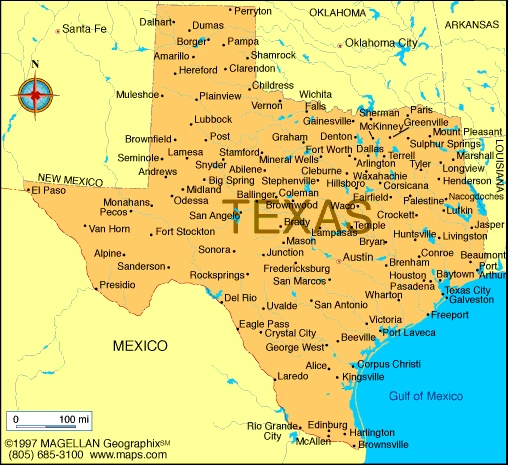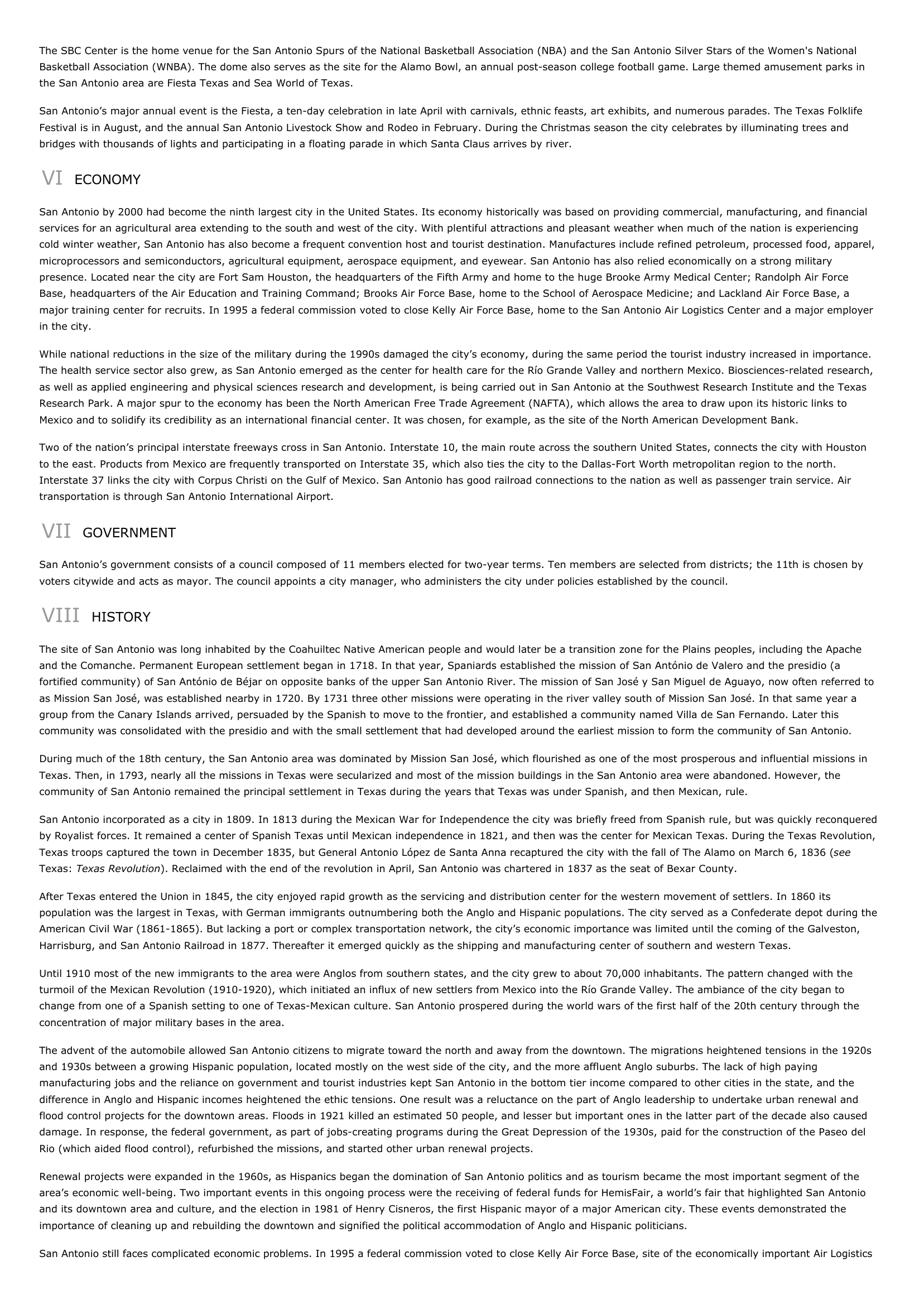San Antonio (city, Texas) - geography.
Publié le 04/05/2013

Extrait du document


«
The SBC Center is the home venue for the San Antonio Spurs of the National Basketball Association (NBA) and the San Antonio Silver Stars of the Women's NationalBasketball Association (WNBA).
The dome also serves as the site for the Alamo Bowl, an annual post-season college football game.
Large themed amusement parks inthe San Antonio area are Fiesta Texas and Sea World of Texas.
San Antonio’s major annual event is the Fiesta, a ten-day celebration in late April with carnivals, ethnic feasts, art exhibits, and numerous parades.
The Texas FolklifeFestival is in August, and the annual San Antonio Livestock Show and Rodeo in February.
During the Christmas season the city celebrates by illuminating trees andbridges with thousands of lights and participating in a floating parade in which Santa Claus arrives by river.
VI ECONOMY
San Antonio by 2000 had become the ninth largest city in the United States.
Its economy historically was based on providing commercial, manufacturing, and financialservices for an agricultural area extending to the south and west of the city.
With plentiful attractions and pleasant weather when much of the nation is experiencingcold winter weather, San Antonio has also become a frequent convention host and tourist destination.
Manufactures include refined petroleum, processed food, apparel,microprocessors and semiconductors, agricultural equipment, aerospace equipment, and eyewear.
San Antonio has also relied economically on a strong militarypresence.
Located near the city are Fort Sam Houston, the headquarters of the Fifth Army and home to the huge Brooke Army Medical Center; Randolph Air ForceBase, headquarters of the Air Education and Training Command; Brooks Air Force Base, home to the School of Aerospace Medicine; and Lackland Air Force Base, amajor training center for recruits.
In 1995 a federal commission voted to close Kelly Air Force Base, home to the San Antonio Air Logistics Center and a major employerin the city.
While national reductions in the size of the military during the 1990s damaged the city’s economy, during the same period the tourist industry increased in importance.The health service sector also grew, as San Antonio emerged as the center for health care for the Río Grande Valley and northern Mexico.
Biosciences-related research,as well as applied engineering and physical sciences research and development, is being carried out in San Antonio at the Southwest Research Institute and the TexasResearch Park.
A major spur to the economy has been the North American Free Trade Agreement (NAFTA), which allows the area to draw upon its historic links toMexico and to solidify its credibility as an international financial center.
It was chosen, for example, as the site of the North American Development Bank.
Two of the nation’s principal interstate freeways cross in San Antonio.
Interstate 10, the main route across the southern United States, connects the city with Houstonto the east.
Products from Mexico are frequently transported on Interstate 35, which also ties the city to the Dallas-Fort Worth metropolitan region to the north.Interstate 37 links the city with Corpus Christi on the Gulf of Mexico.
San Antonio has good railroad connections to the nation as well as passenger train service.
Airtransportation is through San Antonio International Airport.
VII GOVERNMENT
San Antonio’s government consists of a council composed of 11 members elected for two-year terms.
Ten members are selected from districts; the 11th is chosen byvoters citywide and acts as mayor.
The council appoints a city manager, who administers the city under policies established by the council.
VIII HISTORY
The site of San Antonio was long inhabited by the Coahuiltec Native American people and would later be a transition zone for the Plains peoples, including the Apacheand the Comanche.
Permanent European settlement began in 1718.
In that year, Spaniards established the mission of San António de Valero and the presidio (afortified community) of San António de Béjar on opposite banks of the upper San Antonio River.
The mission of San José y San Miguel de Aguayo, now often referred toas Mission San José, was established nearby in 1720.
By 1731 three other missions were operating in the river valley south of Mission San José.
In that same year agroup from the Canary Islands arrived, persuaded by the Spanish to move to the frontier, and established a community named Villa de San Fernando.
Later thiscommunity was consolidated with the presidio and with the small settlement that had developed around the earliest mission to form the community of San Antonio.
During much of the 18th century, the San Antonio area was dominated by Mission San José, which flourished as one of the most prosperous and influential missions inTexas.
Then, in 1793, nearly all the missions in Texas were secularized and most of the mission buildings in the San Antonio area were abandoned.
However, thecommunity of San Antonio remained the principal settlement in Texas during the years that Texas was under Spanish, and then Mexican, rule.
San Antonio incorporated as a city in 1809.
In 1813 during the Mexican War for Independence the city was briefly freed from Spanish rule, but was quickly reconqueredby Royalist forces.
It remained a center of Spanish Texas until Mexican independence in 1821, and then was the center for Mexican Texas.
During the Texas Revolution,Texas troops captured the town in December 1835, but General Antonio López de Santa Anna recaptured the city with the fall of The Alamo on March 6, 1836 ( see Texas: Texas Revolution ).
Reclaimed with the end of the revolution in April, San Antonio was chartered in 1837 as the seat of Bexar County.
After Texas entered the Union in 1845, the city enjoyed rapid growth as the servicing and distribution center for the western movement of settlers.
In 1860 itspopulation was the largest in Texas, with German immigrants outnumbering both the Anglo and Hispanic populations.
The city served as a Confederate depot during theAmerican Civil War (1861-1865).
But lacking a port or complex transportation network, the city’s economic importance was limited until the coming of the Galveston,Harrisburg, and San Antonio Railroad in 1877.
Thereafter it emerged quickly as the shipping and manufacturing center of southern and western Texas.
Until 1910 most of the new immigrants to the area were Anglos from southern states, and the city grew to about 70,000 inhabitants.
The pattern changed with theturmoil of the Mexican Revolution (1910-1920), which initiated an influx of new settlers from Mexico into the Río Grande Valley.
The ambiance of the city began tochange from one of a Spanish setting to one of Texas-Mexican culture.
San Antonio prospered during the world wars of the first half of the 20th century through theconcentration of major military bases in the area.
The advent of the automobile allowed San Antonio citizens to migrate toward the north and away from the downtown.
The migrations heightened tensions in the 1920sand 1930s between a growing Hispanic population, located mostly on the west side of the city, and the more affluent Anglo suburbs.
The lack of high payingmanufacturing jobs and the reliance on government and tourist industries kept San Antonio in the bottom tier income compared to other cities in the state, and thedifference in Anglo and Hispanic incomes heightened the ethic tensions.
One result was a reluctance on the part of Anglo leadership to undertake urban renewal andflood control projects for the downtown areas.
Floods in 1921 killed an estimated 50 people, and lesser but important ones in the latter part of the decade also causeddamage.
In response, the federal government, as part of jobs-creating programs during the Great Depression of the 1930s, paid for the construction of the Paseo delRio (which aided flood control), refurbished the missions, and started other urban renewal projects.
Renewal projects were expanded in the 1960s, as Hispanics began the domination of San Antonio politics and as tourism became the most important segment of thearea’s economic well-being.
Two important events in this ongoing process were the receiving of federal funds for HemisFair, a world’s fair that highlighted San Antonioand its downtown area and culture, and the election in 1981 of Henry Cisneros, the first Hispanic mayor of a major American city.
These events demonstrated theimportance of cleaning up and rebuilding the downtown and signified the political accommodation of Anglo and Hispanic politicians.
San Antonio still faces complicated economic problems.
In 1995 a federal commission voted to close Kelly Air Force Base, site of the economically important Air Logistics.
»
↓↓↓ APERÇU DU DOCUMENT ↓↓↓
Liens utiles
- San Antonio (city, Texas) - geography.
- Williams Charles, 1909-1975, né à San Antonio (Texas), écrivain américain.
- Corpus Christi 1 PRÉSENTATION Corpus Christi, ville des États-Unis, située à 200 km environ au sud-est de San Antonio, dans l'État du Texas.
- SAN ANTONIO (analyse du personnage)
- Fiche de lecture : SAN-ANTONIO de San-Antonio

































